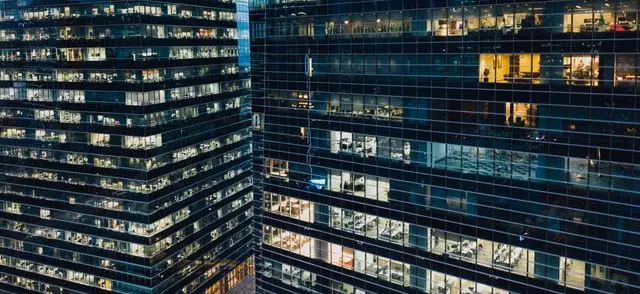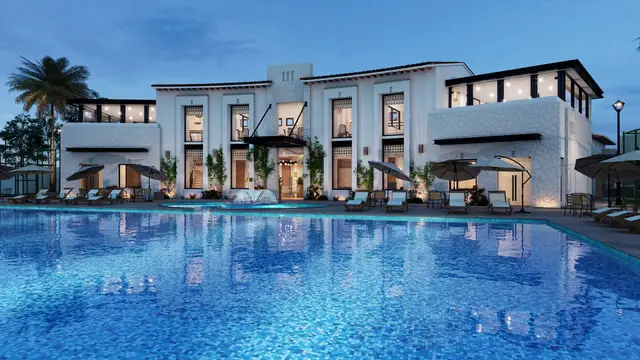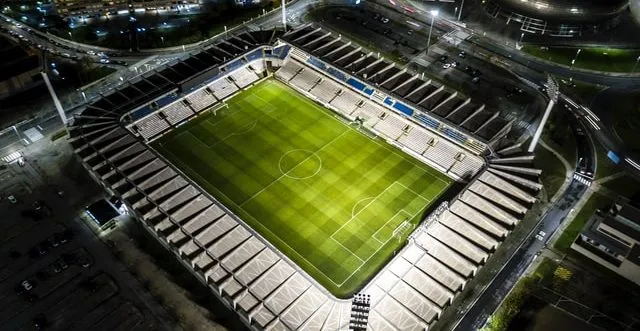Nowadays, real estate can appear in many different ways – from small studio apartments to skyscrapers. In order to get a better understanding of what the purpose of each of these is, they are divided into two main categories: Residential and Commercial Real Estate.
In the following article, we want to focus on commercial properties and how they differ from each other. Here you can find the complete definition of what commercial real estate is.
What is considered commercial real estate?
Commercial Real Estate (CRE) are buildings that have the purpose to generate income and profit from rent or capital gains. They can be divided into 7 categories: Office, Retail, Industrial, Multi-Family Housing, Hotels, Mixed-Use, and Special Purpose Buildings.
Office
Offices make up a large part of the global real estate market and can mostly be found in the centre of cities and towns. These areas are also called “Central Business District” (CBD). A city can also have multiple CBDs, this usually happens when several similar companies settle in the same area and thus attract more businesses.
Office buildings can be divided into 3 tiers: Class A, B, and C.
Class A: … are the best buildings with the most central location and highest build quality. They are the newest, modern offices and offer great amenities.
Class B: … are often a bit older or do not offer the same high quality as class A buildings. It can also be within this tier, because the location is less central. They cost less and thus, are a great opportunity for investors to improve the building.
Class C: … are the least desired offices. They are in an unfavourable location and/or require extensive renovation. Class C buildings have high vacancy rates but also offer the lowest rents.

Retail
Another type of commercial real estate that is popular within city centres, is retail. These units are mostly located on the ground floor so they are easy to reach by their customers. It is also possible that they are completely freestanding and not attached to other types of real estate. Retail stores with the same customer segment settle in the same street/area, as their customers are the most prominent in this part of the city.
There are many different types of retail stores. From small local shops with only a few m² of space, to large shopping malls or outlet centres. From restaurants, bars and clubs, to clothing shops and even bank branches. They can come as a single-tenant building or with several tenants.
Industrial
Industrial real estate can often be found in the outside areas of a city, which still have good transportation access and infrastructure. These factors attract other companies as well, thus forming industrial parks close to major train stations, harbours and airports.
As most other properties that are considered commercial real estate, industrial can be divided further into certain categories.
Manufacturing:
Manufacturing industrial real estate is used for different purposes, either heavy manufacturing or light assembly use-cases.
Heavy manufacturing requires customized buildings that fit exactly the needs of the tenant. This also means that it is very difficult to make use of them, if the company decides to leave the place. Fortunately, tenants usually stay for long periods of time because of the initial investment in customization.
Light assembly is the opposite of heavy manufacturing. This type of commercial real estate has a simple structure and arrangement of equipment, which makes it easy to reconfigure.
Storage/Distribution:
Storage and Distribution centres are used to receive, keep and send away products.
Distribution warehouses specialize in the process of receiving the delivery of a product, storing it for a short amount of time and then sending it to other businesses or the final customer.
Storage warehouses focus on keeping items for a long period of time without immediate distribution. This makes their setup more simple and less costly.
Flex Space:
Flex spaces are industrial properties that do not fit into either of the previous categories and are often a combination of office spaces, storage, assembly and manufacturing. They include for example: data centres, research & development departments, and showrooms.
Multi-Family Housing
In comparison to residential real estate, multi-family housing has the goal to produce income and thus is considered commercial real estate. Every apartment building with at least 4 units or more is a commercial property.
There are three types of multi-family housing. Low-Rise, Mid-Rise, and High-Rise. They can be distinguished by their number of floors and size.
Low-Rise: … or also “garden-style” buildings can mostly be found outside the city centre and in suburbs. They are usually 3-4 floors high and have access to a shared garden/land.
Mid-Rise: … are 5-12 floors high and equipped with an elevator. This type of commercial real estate can be found throughout the whole urban area.
High-Rise: … are more than 10-12 floors high, depending on the market. If a building is more than 40 floors high it can be defined as a skyscraper (300m+ = Supertall; 600m+ Megatall).
Hospitality/Hotels
Hotels or similar types are closely related to multi-family buildings but with mostly short-term stays and a great level of service.
Limited Service: … only provides the basic benefits of a hotel, excluding for example restaurants, room service, concierge, or convention centres. By doing so, they are more budget-friendly.
Full Service: … are more expensive but include a variety of amenities and benefits. They offer more comfort and luxury, which customers are willing to pay for.
Extended Stay: … hospitality also offers only a limited service but is usually equipped with a kitchen to provide enough comfort for long-term stays.

Mixed-Use
Mixed-Use is considered commercial real estate that consists of different types of buildings. Very common are multi-family houses that have retail units on the ground floor. As most cities are very busy and crowded in their main streets, no one wants to live right next to all of this because of the noise and lack of privacy. That is why apartments are located at least on the first floor or higher.
In recent times, mixed-use properties have become more popular as the urban population is rising and there is a lack of space. These not only include retail and multi-family housing, but also offices, hotels, restaurants, hospitals, and more. These buildings are often referred to as Vertical Cities.
Special Purpose Buildings
Special purpose buildings are properties that do not fit into the other categories mentioned before. They also generate income but often offer different services for their tenants/customers.
Some of the most known types are zoos, theaters, healthcare, stadiums, marinas, and many more.

Conclusion
Every type of building that is considered commercial real estate, has some form of income-generating aspect. These properties can be divided into 7 categories: Office, Retail, Industrial, Multi-Family Housing, Hotels, Mixed-Use, and Special Purpose Buildings.
If you want to learn more about commercial real estate, PropTech and Smart Buildings/Cities, feel free to take a look at our other articles.

